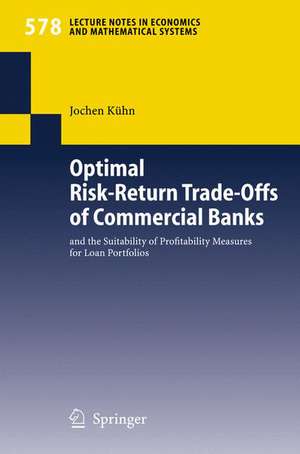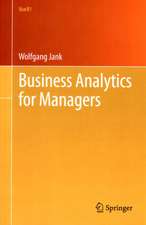Optimal Risk-Return Trade-Offs of Commercial Banks: and the Suitability of Profitability Measures for Loan Portfolios: Lecture Notes in Economics and Mathematical Systems, cartea 578
Autor Jochen Kühnen Limba Engleză Paperback – 14 aug 2006
Din seria Lecture Notes in Economics and Mathematical Systems
-
 Preț: 360.02 lei
Preț: 360.02 lei -
 Preț: 383.93 lei
Preț: 383.93 lei -
 Preț: 384.09 lei
Preț: 384.09 lei -
 Preț: 380.07 lei
Preț: 380.07 lei -
 Preț: 446.26 lei
Preț: 446.26 lei -
 Preț: 497.37 lei
Preț: 497.37 lei -
 Preț: 380.84 lei
Preț: 380.84 lei -
 Preț: 384.86 lei
Preț: 384.86 lei -
 Preț: 378.34 lei
Preț: 378.34 lei -
 Preț: 399.67 lei
Preț: 399.67 lei - 20%
 Preț: 360.93 lei
Preț: 360.93 lei - 15%
 Preț: 643.16 lei
Preț: 643.16 lei -
 Preț: 379.09 lei
Preț: 379.09 lei -
 Preț: 404.74 lei
Preț: 404.74 lei -
 Preț: 385.62 lei
Preț: 385.62 lei - 15%
 Preț: 644.49 lei
Preț: 644.49 lei -
 Preț: 379.09 lei
Preț: 379.09 lei -
 Preț: 345.50 lei
Preț: 345.50 lei -
 Preț: 425.80 lei
Preț: 425.80 lei -
 Preț: 378.34 lei
Preț: 378.34 lei - 18%
 Preț: 775.65 lei
Preț: 775.65 lei -
 Preț: 392.60 lei
Preț: 392.60 lei -
 Preț: 401.61 lei
Preț: 401.61 lei - 15%
 Preț: 646.43 lei
Preț: 646.43 lei -
 Preț: 382.18 lei
Preț: 382.18 lei -
 Preț: 378.34 lei
Preț: 378.34 lei - 15%
 Preț: 637.59 lei
Preț: 637.59 lei - 15%
 Preț: 647.27 lei
Preț: 647.27 lei -
 Preț: 377.73 lei
Preț: 377.73 lei -
 Preț: 447.84 lei
Preț: 447.84 lei - 15%
 Preț: 644.49 lei
Preț: 644.49 lei -
 Preț: 386.00 lei
Preț: 386.00 lei - 15%
 Preț: 654.43 lei
Preț: 654.43 lei -
 Preț: 415.02 lei
Preț: 415.02 lei -
 Preț: 411.54 lei
Preț: 411.54 lei -
 Preț: 398.92 lei
Preț: 398.92 lei -
 Preț: 398.92 lei
Preț: 398.92 lei -
 Preț: 392.75 lei
Preț: 392.75 lei - 15%
 Preț: 635.47 lei
Preț: 635.47 lei - 20%
 Preț: 653.56 lei
Preț: 653.56 lei -
 Preț: 379.86 lei
Preț: 379.86 lei -
 Preț: 495.46 lei
Preț: 495.46 lei -
 Preț: 447.99 lei
Preț: 447.99 lei -
 Preț: 378.71 lei
Preț: 378.71 lei - 15%
 Preț: 637.13 lei
Preț: 637.13 lei -
 Preț: 385.84 lei
Preț: 385.84 lei -
 Preț: 378.54 lei
Preț: 378.54 lei - 15%
 Preț: 666.55 lei
Preț: 666.55 lei -
 Preț: 380.07 lei
Preț: 380.07 lei
Preț: 380.63 lei
Nou
Puncte Express: 571
Preț estimativ în valută:
72.84€ • 75.25$ • 60.62£
72.84€ • 75.25$ • 60.62£
Carte tipărită la comandă
Livrare economică 25 martie-08 aprilie
Preluare comenzi: 021 569.72.76
Specificații
ISBN-13: 9783540348191
ISBN-10: 3540348190
Pagini: 164
Ilustrații: IX, 152 p.
Dimensiuni: 155 x 235 x 12 mm
Greutate: 0.24 kg
Ediția:2006
Editura: Springer Berlin, Heidelberg
Colecția Springer
Seria Lecture Notes in Economics and Mathematical Systems
Locul publicării:Berlin, Heidelberg, Germany
ISBN-10: 3540348190
Pagini: 164
Ilustrații: IX, 152 p.
Dimensiuni: 155 x 235 x 12 mm
Greutate: 0.24 kg
Ediția:2006
Editura: Springer Berlin, Heidelberg
Colecția Springer
Seria Lecture Notes in Economics and Mathematical Systems
Locul publicării:Berlin, Heidelberg, Germany
Public țintă
ResearchCuprins
Risk Measures.- Asset Pricing.- Reward-to-Risk Ratios.- Effects of Risk-Taking in Commercial Banks.- Risk-Return Trade-Offs for Commercial Banks.- Deposits and the Risk-Return Trade-Off.- Profitability Measures for Loan Portfolios.- Conclusion.
Textul de pe ultima copertă
The present book criticizes the fact that profitability measures derived from capital market models such as the Sharpe ratio and the reward-to-VaR ratio are proposed for loan portfolios although it is not assessed whether their risk-return trade-offs are optimal for banks. This volume intends to fill this gap.
The approach of this work is to endogenously derive optimal risk-return trade-offs of commercial banks and to compare them with those of reward-to-risk ratios. The risk-return trade-offs for banks are derived taking into account market discipline, Basel I and Basel II regulatory capital requirements, and insured deposits.
It is found that even the reward-to-VaR ratio, which is explicitly developed for the purpose of valuating loan portfolios, can be highly misleading. The volume also helps in understanding risk management motives of banks, in particular, how market discipline, capital requirements, and insured deposits affect the decision-making of banks.
The approach of this work is to endogenously derive optimal risk-return trade-offs of commercial banks and to compare them with those of reward-to-risk ratios. The risk-return trade-offs for banks are derived taking into account market discipline, Basel I and Basel II regulatory capital requirements, and insured deposits.
It is found that even the reward-to-VaR ratio, which is explicitly developed for the purpose of valuating loan portfolios, can be highly misleading. The volume also helps in understanding risk management motives of banks, in particular, how market discipline, capital requirements, and insured deposits affect the decision-making of banks.

















